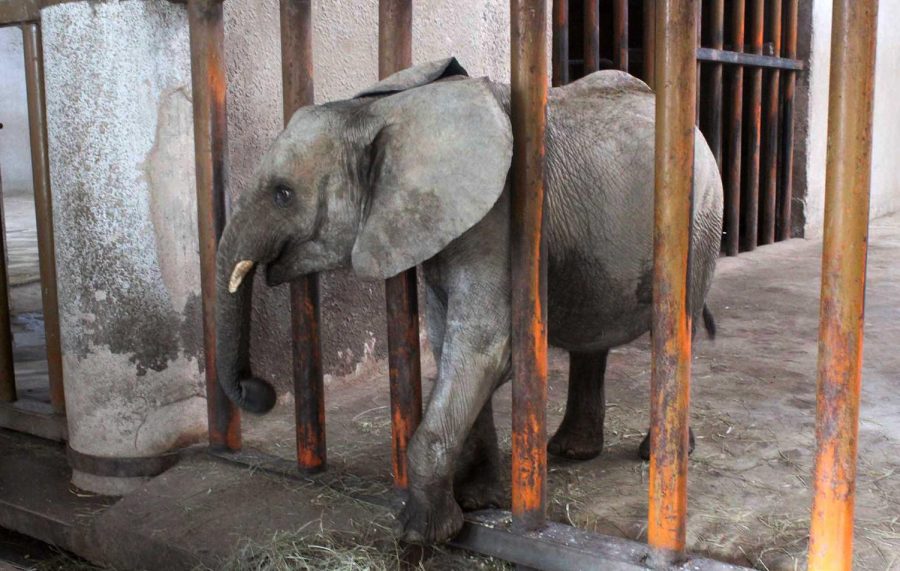Elephant Cruelty in Zimbabwe
Zimbabwe, Africa is currently suffering from disastrous food and water shortages, creating serious implications on Hwange national park. This massive park, located on the northernmost frontier of Zimbabwe, is widely known for the large amount of elephants accommodated. What is not common knowledge, however, is the boma compound that exists on the southeast side of the park. It contains elephants ranging from two to six years old, taken away from their mothers and crowded into a holding pen before transportation. The costs of maintaining the sanctuary outweigh the profits, and so, to make up for lost money, park officials have been legally selling young elephants to China and numerous other countries. These elephants will spend their lives in captivity inside of zoos and circuses. “We believe that elephants must pay for their upkeep. They must also pay for their protection,” says veteran ranger of Hwange, Patrick Sibanda. They have “elephants to spare” with a population ranging between 45,000 and 53,000 in the park, while the actual environment can only sustain around 15,000.
With rain arriving later each year, the drought has been drying up water sources, leading to the deaths of around 200 elephants since October. The selling of these young mammals has been blamed on the drought and labeled the park’s conservation efforts. The money made from these trades has been said to be spent on repairing artificial water holes for the animals. . However, the details of the trades and the conditions of the imprisoned animals have been willfully concealed. Chrispen Chikadaya, a senior inspector with the Zimbabwe National Society for the Prevention of Cruelty to Animals (ZNSPCA), said that when he originally examined the elephants in 2018, park officials said that they would be moved out within a month, but they remained there for almost one whole year. This has ignited serious controversy, propelled by the fact that elephants in captivity suffer more illnesses, are less fertile, and die at a younger age. The ZNSPCA team has legal authority to inspect captive animals at any time, but was forcefully kept out of the compound. Tinashe Farawo, a representative of Zimbabwe National Parks and Wildlife Management Authority, has denied all accusations of animal abuse. Lingering rumors of elephants left behind in the boma compound, although denied by park officers, propelled ZNSPCA to initiate a court debate. ZNSPCA won the debate and were granted access to the compound, where they found two scrawny, young elephants.
A treaty has been formed to control international animal trade and preventing the trade of African elephants to other continents. However, with the Zimbabwean President hinting at a way out of the agreement, activists fear the trade moving underground.
McKenzie, David. “Young Elephants Were Taken from Their Mothers in Zimbabwe. Now They’re in Cages in China.” CNN, Cable News Network, 25 Nov. 2019, www.cnn.com/2019/11/24/africa/zimbabwe-elephant-trade-intl/index.html.
Cockburn, Harry. “Outrage as 30 Wild Baby Elephants ‘Flown from Zimbabwe to China for Lifetime in Captivity’.” The Independent, Independent Digital News and Media, 25 Oct. 2019, www.independent.co.uk/news/world/africa/baby-elephants-zimbabwe-sold-china-captivity-zoo-wildlife-drought-a9170886.html.
“Zimbabwe Sent 30 Baby Elephants to China, to Dismay of Animal Rights Groups.” South China Morning Post, 26 Oct. 2019, www.scmp.com/news/world/africa/article/3034676/zimbabwe-sent-30-baby-elephants-china-dismay-animal-rights-groups.
Press, Associated. “More than 50 Elephants Starve to Death in Zimbabwe Drought.” The Guardian, Guardian News and Media, 21 Oct. 2019, www.theguardian.com/world/2019/oct/22/more-than-50-elephants-starve-to-death-in-zimbabwe-drought.
